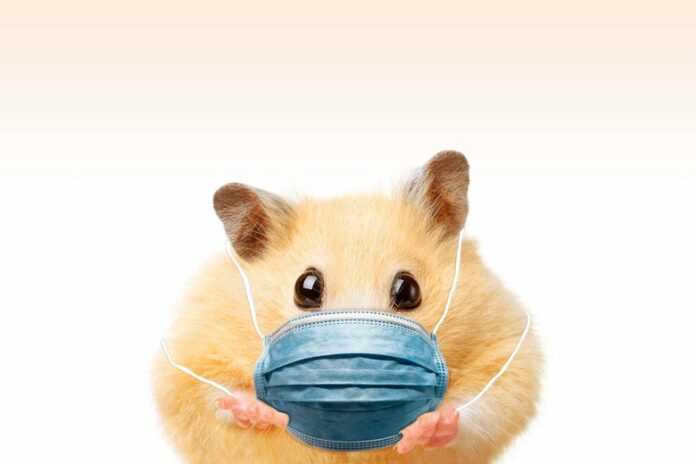The thing about hamsters is: They’re not people!
Also, the hamsters didn’t actually wear the masks.
Photo illustration by Slate. Photos by Getty Images Plus.
This is an entry in Viral Studies, a Slate series in which we break down recent viral articles and—most importantly—their caveats.
Hamsters might reasonably use surgical masks as room dividers to slow the spread of the coronavirus, some unpublished research suggests. That is the real takeaway from a study that has gone a little viral, as studies are wont to do in this age of the coronavirus.
Hong Kong University microbiologist Yuen Kwok-yung first described his work to news outlets in Asia on Sunday. Fifty-two hamsters reportedly participated. Yuen and his team housed the hamsters in a series of cages, infecting the residents of half with the coronavirus (yes, a paper in review suggests hamsters can get the coronavirus). The researchers paired infected cages with uninfected cages, putting each side by side, explains the South China Morning Post. In one scenario, the infected hamsters had masks shielding their cages “as if they were wearing a mask,” as a Radio Television Hong Kong story put it. In another scenario, the masks were on the cages of uninfected hamsters. Cages in a control scenario had no mask dividers at all. Fans blew air between the cages, to help the virus travel.
The surgical masks proved helpful in slowing the infection rate from one cage to another, most of all in the scenario where the masks were attached to the infected cage itself. “The findings implied to the world and the public is that the effectiveness of mask-wearing against the coronavirus pandemic is huge,” Yuen said.
From there, CNBC picked up the story, topping a report of the results with a photo of a human woman in a mask, and the headline “Wearing a mask can reduce coronavirus transmission by 75%, new study claims.” The story explained that the research “gives weight to arguments by medical professionals and government leaders that wearing a mask does indeed reduce virus transmission—and dramatically so.” Experiments in Hong Kong showed that the transmission rate “dropped by as much as 75% when surgical masks were used.” In an earlier version of the piece, the hamster subjects make their first appearance by paragraph five. A few hours after publication, the CNBC story was updated with a headline to reflect the hamsters’ participation. Some language was added to the piece to note that the study appears “yet to be peer reviewed.” It is worth noting that the author of the story is a Mideast correspondent who, like most journalists right now, has been drafted to cover the coronavirus.
Famous news anchor Chris Hayes tweeted the piece, commenting: “I’ve come to believe there is no magic bullet for Covid until vaccination but that universal mask-wearing is the closest we have.”
Hayes, the CNBC story, and Yuen reflect a belief that masks meaningfully—actually, dramatically—lower the transmission rates of the novel coronavirus among civilians. This belief is so deeply held that we take hospital-grade gear for ourselves and shame people who go without masks even while maintaining social distancing in the outdoors. I am intentionally calling it a belief because the science on how much masks help is still fuzzy. As we learn more about asymptomatic transmission, including from experiments like Yuen’s, it seems that, yes, wearing a mask as a way to protect others from your germs is worthwhile (when they are worn properly and cleaned or disposed of between use, which … often they are not). Certainly, you should be wearing a mask regularly at this point, largely because masks are now required in parts of the U.S. and—as has long been the case in Asia—operate as symbols of participation in the collective good.
Even so, we are at risk of overrelying on masks. Before masks became widespread here, many experts worried that masks not only might not help that much, but could embolden us with a false sense of security. We should still worry about this, I think. Because if the masks are second best to a silver bullet—well, what is social distancing, hand-washing, the painful reality of being stuck inside? The truest part of Hayes’ tweet is that there is no magic bullet right now. What a small study on hamsters should illustrate is that we’re still learning.
For more of Slate’s coverage of COVID-19, listen to What Next.






